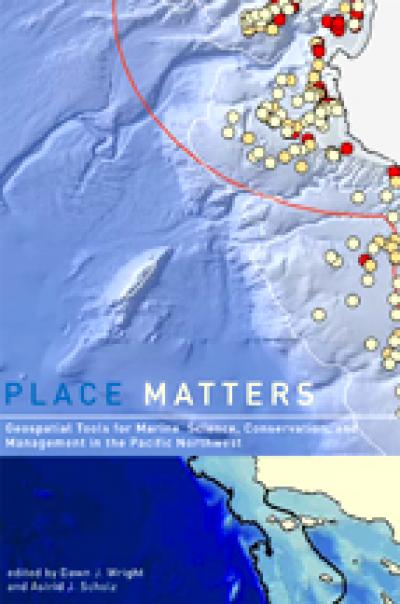
An Identification Guide to the Larval Marine Invertebrates of the Pacific Northwest
Alan L. Shanks
The study of larval invertebrates is a vital and growing field in contemporary marine science. The key ecological role of larvae in determining adult population sizes has been recognized for decades and has inspired extensive research. This volume, the first of its kind, is an identification guide to the planktonic larvae of shallow subtidal and intertidal invertebrates common to the Pacific Northwest coast.
Each chapter provides a brief background to the larval biology of an invertebrate group; keys, line drawings, and descriptions for the identification of larvae; a list of the species present in the Pacific Northwest; and a reference section. The geographic range covered is roughly from southeast Alaska to northern California; however many of the species are found along the entire coast of California, as far south as Baja California.
An essential reference for anyone attempting to identify larval invertebrates from zooplankton samples, this working manual is intended for students as well as scientists and researchers. It offers an important new resource for marine biologists, biological oceanographers, marine and intertidal ecologists, and especially larval biologists.
About the author
Alan L. Shanks is Associate Professor of Biology at the Oregon Institute of Marine Biology in Charleston, Oregon.
Read more about this author
Introduction
- Porifera: The Sponges
by Steven Sadro - Cnidaria (Coelenterata)
by Steven Sadro - Platyhelminthes: The Flatworms with an Emphasis on Marine Turbellaria
by Alan L. Shanks - Nemertea: The Ribbon Worms
by Kevin B. Johnson - Entoprocta
by Alan L. Shanks - Polychaeta
by Lana Crumrine - Sipuncula: The Peanut Worms
by Kevin B. Johnson - Echiura and Pogonophora: The Coelomate Worms
by Alan L. Shanks - Mollusca: Gastropoda
by Jeffrey H.R. Goddard - Mollusca: Bivalvia
by Laura A. Brink - Mollusca: The Smaller Groups Polyplacophora, Scaphopoda, and Cephalopoda
by Alan L. Shanks - Arthropoda, Cirripedia: The Barnacles
by Andrew J. Arnsberg - Arthropoda: Isopoda
by Steven Sadro - Arthropoda: Decapoda
by Amy L. Puls - Phoronida
by Kevin B. Johnson - Bryozoa
by Katherine Rafferty - Brachiopoda
by Alan L. Shanks - Echinodermata
by Bruce A. Miller - Hemichordata, Class Enteropneusta: The Acorn Worms
by Alan L. Shanks - Urochordata: Ascidiacea
by Steven Sadro
Index
Many marine invertebrates produce larvae that spend time in the plankton. Many species are broadcast spawners: eggs and sperm are shed into the water, where fertilization occurs, and the zygote then goes through its development in the water column. Other species have internal fertilization and brood the larvae to a more advanced stage of development before they are released into the plankton. Finally, some species brood their young to such an advanced stage of development that they are release as crawl-away juveniles. There are many reasons one might study larval invertebrates: they have fascinating and complex patterns of development, they are uniquely adapted to a temporary life as zooplankters, they play a major role in establishing adult population size, and many larval types are quite beautiful.
The geographic range covered by this manual is roughly from British Columbia to northern California, though many of our species are also found along the coast of California and even Baja California. For example, of the 46 species of crabs listed in the Intertidal Invertebrates of California (Morris et al.,1980), 54% have ranges that extend into southern Oregon. Of the 33 crabs listed in Light's Manual: Intertidal Invertebrates of the Central California Coast (Smith and Carlton, 1975), 85% are found in the Pacific Northwest. Thus, researchers and students along the entire West Coast should find this guide to larval invertebrates useful.
Populations of benthic marine invertebrates are often characterized by large fluctuations in the size of adult populations (McEdward, 1995). Most of these benthic invertebrates produce larvae that spend, depending on the species, from minutes to months developing in the plankton. Current research suggests that the fluctuations in adult population size maybe caused by variations in the relative recruitment of their larvae; they have to survive their pelagic phase. Larval mortality can be from predation, starvation, or transport of the larvae away from suitable habitats in which to settle (Rumrill, 1990; and Thorson 1946).
The importance of the larval period in determining adult population size has been recognized for decades (Thorson, 1946) and has inspired a great deal of research. An important limiting factor in this area of research is the problem of larval taxonomy; it is difficult to study any; aspect of larval biology if one cannot identify the larvae. For example, the larvae of estuarine-dependent invertebrates (e.g., ghost shrimp) can be exported from an estuary; their development would then take place over the continental shelf, after which they must reinvade the estuary. Alternately, the entire larval development can occur within the estuary. It is impossible to address even such a simple topic as the location of larval development if one cannot identify the larvae.
Because of the economic importance of fishes, their larvae have received a great deal of research, and excellent volumes describing them are available for both the east and west coasts of North America (e.g., Fahay 1983; Matarese et al., 1989). No similar volumes are available for any invertebrate groups from the West Coast. Papers, graduate dissertations, and reports that describe the larvae of West Coast invertebrates have been published, but because these descriptions are scattered throughout a large literature (more that 100 years' publications in at least several dozen journals) their utility is diminished. Further, the larvae of many common coastal invertebrates have not been described. The purpose of this volume is to begin to fill this void in our knowledge.
This identification guide is aimed at individuals who are attempting to identify larval invertebrates from zooplankton samples. We assume that the user has a basic knowledge of invertebrates zoology. To assist even the novice user of this volume, however, each chapter includes a brief description of the typical life cycle(s) of the organisms in the group; the key characteristics of their larvae; a list of the shallow-water invertebrate species found in the Pacific Northwest and whether there are descriptions of their larvae; a key to the larvae for which we have published descriptions; and a reference section. In the keys, we attempt to use characteristics that are readily apparent in preserved samples, under a dissecting (or compound) microscope and without the need for dissection.
There are several limitations to this manual. The first, and most obvious, is that this guide has been constructed from published descriptions of larvae. For a few taxonomic groups the larvae of most of the local species have been described (e.g., barnacles and phoronids), but for the vast majority of groups only a portion, often a small portion, of the larvae have been described. Depending on the taxonomic group, this limitation means that one's identification of a larva may range from being pretty accurate to quite problematic. Second, this guide was to a large extent written by people who have not been trained as taxonomists. Much of it was written by undergraduate and graduate students Because of our inexperience, errors will have crept into the guide, Third, this guide is untried. We expect that as it is used the users will find errors; this is inevitable. We would love to get your feedback so that we can improve and update the volume.
We hope that a byproduct of this guide will be new descriptions of previously undescribed larvae. There are two methods to identify unknown larvae. living larvae can be removed from a plankton sample and reared until they have metaphorphosed into their adult morphology, at which point one of the numerous guides to coastal invertebrates can be used to identify the species. To a large extent this is what Thorson did for his classic volume on Danish marine invertebrate larvae (Thorson, 1946). The alternate is to spawn the adults and rear the larvae. An excellent guide to this procedure for a large number of species can be found in Strathmann (1987). We will be happy to receive new larval descriptions and incorporate them into future guides.
During the preparation of this book we found many references in which it was obvious that researchers had raised a particular larval type through its development, but, because the purpose of the paper was something other than the publication of a larval description, none was provided. This was particularly frustrating during the writing of the chapter on bivalves. To study their potential for mariculture, many shallow-water West Coast bivalves have been raised in the lab. But few of the associated publications provide any description of the larvae. We strongly encourage researchers to include descriptions and pictures of larvae in their papers. Ideally, this description should extend across the ontogenetic stages of the larvae, presenting photographs or line drawing of the different larval stages and key characteristics that would help one to identify the larvae when found in the plankton. This information should add no more than a page or two to an article. Over time, these additions to the published descriptions will greatly expand our current knowledge.




